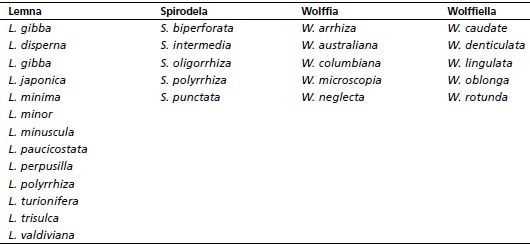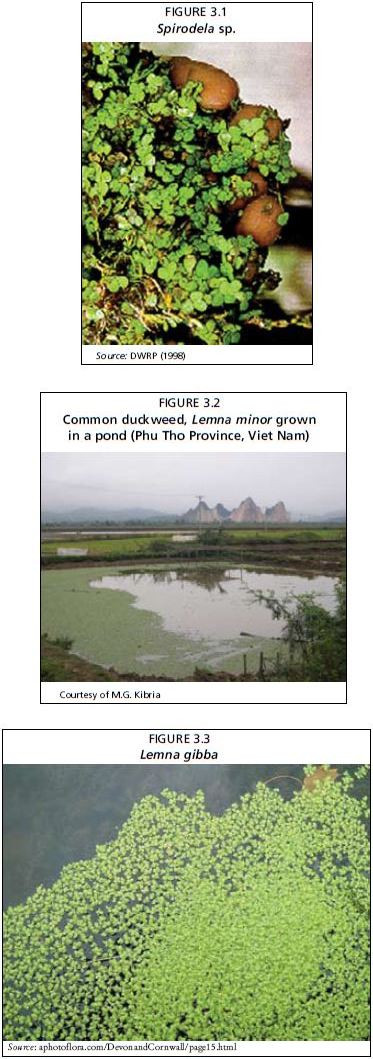3 Floating aquatic macrophytes – Duckweeds
Duckweeds are small (1-15 cm) free-floating aquatic plants with worldwide distribution. They are monocotyledons belonging to the family Lemnaceae (which is derived from the Greek word ‘Limne’, meaning pond) and are classified as higher plants or macrophytes, although they are often mistaken for algae and some taxonomists consider them as being members of the Araceae. Duckweeds serve as nutrient pumps, reduce eutrophication effects and provide oxygen from their photosynthesising activity.
Duckweeds are often seen growing in thick blanket-like mats on still nutrient rich fresh and slightly brackish waters. They do not survive in fast moving water (>0.3 m/sec) or water unsheltered from the wind. They grow at water temperatures between 6 and 33 ?C (Leng, Stambolie and Bell, 1995).
3.1 Classification
Duckweed consists of four genera: Lemna, Spirodela, Wolffia and Wolffiella. So far, 37 species belonging to the four genera have been identified from different parts of the world. Selected species are listed in Table 3.1. Taxonomically the family is complicated by clonal characteristics (Culley et al., 1981). The most commonly available species belong to the three genera Lemna, Spirodela and Wolffia. Illustrations of selected species of duckweeds are given in Figures 3.1 - 3.3. It is quite common for floating mats of duckweeds to consist of more than one species, e.g. Lemna and Wolffia.
Lemna is the largest genera of the family Lemnaceae. Lemna is among the most complex and confusing groups within the entire family. Landolt (1986) hypothesized that Lemna disperna and Lemna gibba are related as progenitor-derivative species and the former species differentiated from the latter one. Reduction of some structures such as frond size, number of nerves and the number of ovules in Lemna disperna, along with its narrower geographic distribution, support the hypothesis that it was derived from Lemna gibba or from a common ancestor. Lemna disperna has a chromosome number of 2n = 40, whereas the numbers 2n = 40, 50, 70 and 80 have been found in
Table 3.1
Classification of selected species of duckweeds


Figure 3.1
Spirodela sp.
Source: DWRP (1998)
Figure 3.2
Common duckweed, Lemna minor grown in a pond (Phu Tho Province, Viet Nam) Courtesy of M.G. Kibria
Figure 3.3
Lemna gibba
Source: aphotoflora.com/DevonandCornwall/page15.html
Floating aquatic macrophytes – Duckweeds 31
Lemna gibba (Crawford et al., 2005). The allozyme study supports the continued recognization of two species and is concordant with the hypothesis that the species are related as progenitor and derivative. The reduced morphology of Lemna disperna and the allozyme data indicate that this species originated via dispersal of Lemna gibba or of a common ancestor of the two species.